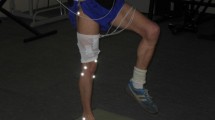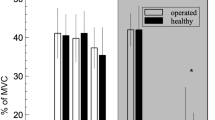Abstract
Purpose
To compare the improvement of the vastus medialis component of the quadriceps muscle electrophysiologically after the subvastus and medial parapatellar approaches in total knee arthroplasty (TKA).
Methods
A total 26 patients that underwent primary unilateral in TKA were included into the study. TKAs were carried out via subvastus approach in 15 patients, while 11 patients were operated via medial parapatellar approach. The electrophysiological evaluations were carried out blindly with regard to the type of the surgical approach before the operation and at 6th week post-operatively. Non-surgical side was also evaluated as a control. Assessments were patellar tendon reflex analysis, motor unit potential analysis and interference pattern analysis (IPA) including turn–amplitude analysis and IPA during maximum contraction.
Results
When they were compared to the pre-operative values, “the total mean amplitude” and “the mean turn/sec” parameters were significantly increased in group of subvastus approach (p = 0.017 and p = 0.009, respectively) at the post-operative 6th week. We would not be able to find any difference regarding the other electrophysiological parameters. There was also no significant difference between groups.
Conclusion
If there was no significant difference in all the electrophysiological parameters, the increase in turn–amplitude analysis in the group of subvastus approach would be considered as an indicator of a faster functional improvement of knee extensor mechanism in these cases.
Level of evidence
Diagnostic study, Level III.
Similar content being viewed by others
References
Berend ME (2012) Evaluation and management of complications of the extensor mechanism. Instr Course Lect 61:405–409
Bindelglass DF, Vince KG (1996) Patellar tilt and subluxation following subvastus and parapatellar approach in total knee arthroplasty. J Arthroplast 11(5):507–511
Boerger TO, Aglietti P, Mondanelli N, Sensi L (2005) Mini-subvastus versus medial parapatellar approach in total knee arthroplasty. Clin Orthop Relat Res 440:82–87
Bonutti PM, Zywiel MG, Ulrich SD, Stroh DA, Seyler TM, Mont MA (2010) A comparison of subvastus and midvastus approaches in minimally invasive total knee arthroplasty. J Bone Jt Surg Am 2(3):575–582
Bourke MG, Buttrum PJ, Fitzpatrick PL, Dalton PA, Jull GA, Russell TG (2010) Systematic review of medial parapatellar and subvastus approaches in total knee arthroplasty. J Arthroplast 25(5):728–734
Cushner F (2003) The subvastus approach to the knee. J Knee Surg 16(suppl 1):52–54
Dafkin C, Green A, Kerr S, McKinon W (2012) The patellar reflex: does activity of quadriceps femoris muscles reflect leg movement? Neurol Res 34(6):623–626
Dutka J, Skowronek M, Sosin P, Skowronek P (2011) Subvastus and medial parapatellar approaches in TKA: comparison of functional results. Orthopedics 34(6):148–153
Finsterer J (2001) EMG-interference pattern analysis. J Electromyogr Kinesiol 11(4):231–246
Fuglsang-Frederiksen A (2000) The utility of interference pattern analysis. Muscle Nerve 23:18–36
Hay GC, Kampshoff J, Kuster MS (2010) Lateral subvastus approach with osteotomy of the tibial tubercle for total knee replacement: a two-year prospective, randomised, blinded controlled trial. J Bone Jt Surg Br 92(6):862–866
Hofmann AA, Plaster RL, Murdock LE (1991) Subvastus (Southern) approach for primary total knee arthroplasty. Clin Orthop Relat Res 269:70–77
Lorentzen JS, Petersen MM, Brot C, Madsen OR (1999) Early changes in muscle strength after total knee arthroplasty. Acta Orthop Scand 70(2):176–179
Moore BD, Drouin J, Gansneder BM, Shultz SJ (2002) The differential effects of fatigue on reflex response timing and amplitude in males and females. J Electromyogr Kinesiol 12(5):351–360
Nikolopoulos DD, Polyzois I, Apostolopoulos AP, Rossas C, Moutsios-Rentzos A, Michos IV (2011) Total knee arthroplasty in severe valgus knee deformity: comparison of a standard medial parapatellar approach combined with tibial tubercle osteotomy. Knee Surg Sports Traumatol Arthrosc 19(11):1834–1842
Nirkko AC, Rösler KM, Hess CW (1995) Sensitivity and specificity of needle electromyography: a prospective study comparing automated interference pattern analysis with single motor unit potential analysis. Electroencephalogr Clin Neurophysiol 97(1):1–10
Ogata K, İshinishi T, Hara M (1997) Evalution of patellar retinacular tension during total knee arthroplasty. Special emphasis on lateral retinacular release. J Arthroplast 12(6):651–656
Pfeiffer G, Kunze K (1992) Turn and phase counts of individual motor unit potentials: correlation and reliability. Electroencephalogr Clin Neurophysiol 85(3):161–165
Rand JA (2005) Extensor mechanism complications after total knee arthroplasty. Instr Course Lect 54:241–250
Ritter MA, Pierce MJ, Zhou H, Meding JB, Faris FM, Keating EM (1999) Patellar complications (Total knee arthroplasty). Effect of lateral retinacular release and thickness. Clin Orthop Relat Res 367:149–157
Roysam GS, Oakley MJ (2001) Subvastus approach for total knee arthroplasty. J Arthroplast 16(4):454–457
Thienpont E (2012) Faster recovery after minimally invasive surgery in total knee arthroplasty. Knee Surg Sports Traumatol Arthrosc. doi:10.1007/s00167-012-1978-6
van Hemert WL, Senden R, Grimm B, van der Linde MJ, Lataster A, Heyligers IC (2011) Early functional outcome after subvastus or parapatellar approach in knee arthroplasty is comparable. Knee Surg Sports Traumatol Arthrosc 19(6):943–951
White RE, Allman JK, Trauger JA, Dales BH (1999) Clinical comparison of the midvastus and medial parapatellar surgical approaches. Clin Orthop Relat Res 367:117–122
Zhang LQ, Huang H, Sliwa JA, Rymer WZ (1999) System identification of tendon reflex dynamics. IEEE Trans Rehabil Eng 7(2):193–203
Author information
Authors and Affiliations
Corresponding author
Rights and permissions
About this article
Cite this article
Aydogdu, S., Zileli, B., Cullu, E. et al. Increased turn/amplitude parameters following subvastus approach in total knee arthroplasty. Knee Surg Sports Traumatol Arthrosc 22, 1632–1637 (2014). https://doi.org/10.1007/s00167-012-2358-y
Received:
Accepted:
Published:
Issue Date:
DOI: https://doi.org/10.1007/s00167-012-2358-y




